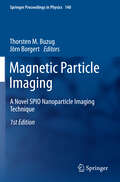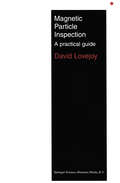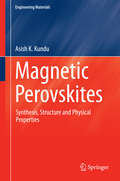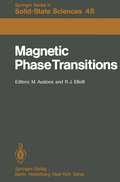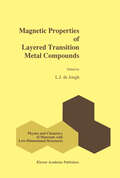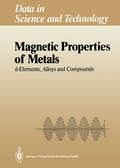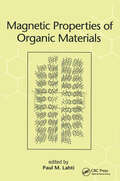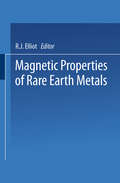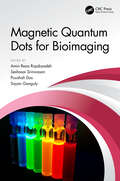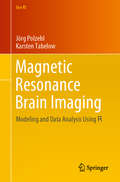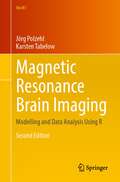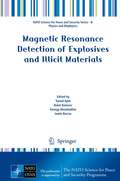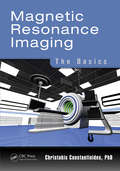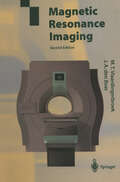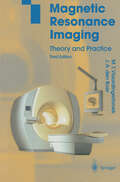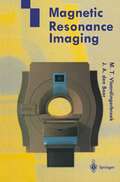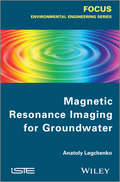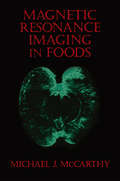- Table View
- List View
Magnetic Particle Imaging: A Novel SPIO Nanoparticle Imaging Technique (Springer Proceedings in Physics #140)
by Thorsten M. Buzug Jö BorgertMagnetic Particle Imaging (MPI) is a novel imaging modality. In MPI superparamagnetic iron oxide nanoparticles are used as tracer materials. The volume is the proceeding of the 2nd international workshop on magnetic particle imaging (IWMPI). The workshop aims at covering the status and recent developments of both, the instrumentation and the tracer material, as each of them is equally important in designing a well performing MPI. For instance, the current state of the art in magnetic coil design for MPI is discussed. With a new symmetrical arrangement of coils, a field-free line (FFL) can be produced that promises a significantly higher sensitivity compared with the standard arrangement for a FFP. Furthermore, the workshop aims at presenting results from phantom and pre-clinical studies.
Magnetic Particle Inspection: A practical guide
by M.J. LovejoyDuring the years since this book was first published in 1993 there have very few developments in the technology of magnetic particle inspection apart from improvements in instrumentation which has made the measurement of peak values of time varying currents practicable. The major changes have arisen from health and safety and environmental concerns. These involve chemicals and exposure of personnel to air-borne electromagnetic fields and long wave ultraviolet (UY.A). The changes in the acceptability of certain volatile halogenated hydrocar bons which led to the banning of 1, 1, 1 thichloroethane in 1995 were evident in 1993. The present discussions concerning the emissions of volatile organic compounds (VOCs) in general was also current and has now reached a stage where the effects of these deliberations will become evident over the next few years. Concerns over the exposure of personnel to airborne electromagnetic fields has been current for some years as has discussions to the effects of long wave ultraviolet (UY.A) on human skin. Recommendations as to maximum permit ted exposures over periods of time to both of these phenomena have been put forward and will doubtless form the basis of future legislation on the matter. A number of new specifications have appeared notably EN (European) and ISO specifications and some of these are still in preparation. Generally their impact will be minimal since these specifications are largely derived from existing documentation.
Magnetic Perovskites: Synthesis, Structure and Physical Properties (Engineering Materials)
by Asish K KunduMagnetic perovskite with multi functional properties (magneto-resistive, magneto-dielectric, multiferroics, spintronics, etc.) have attracted increasing attention due to their possible applications towards storage materials and intriguing fundamental Physics. Despite the numerous investigations on multi functional materials in the past few years, a very few magnetic perovskites have been known to realize as ferromagnetic-insulators. In perovskites centred transition metal oxides strong interplay between lattice, charge, spin and/or orbital degrees of freedom provide a fantastic playground to tune their physical properties. The main purpose of this book is to introduce the phenomenon and physics of complex magnetism (phase separation, spin glass, frustrations, etc.) in perovskite manganites and cobaltites via an experimental approach. The book is organized into four chapters; Chap. 1 gives a brief introduction of various interesting phenomena in magnetic perovskites. Chapter 2 describes the results of the investigations on electronic phase separation and glassy ferromagnetism of the hole-doped perovskite manganites and cobaltites. Ordered and disordered effects and related aspects in hole-doped perovskite cobaltites are described in Chap. 3. Finally, in Chap. 4 the bismuth based magnetic perovskite is discussed.
Magnetic Phase Transitions: Proceedings of a Summer School at the Ettore Majorana Centre, Erice, Italy, 1–15 July, 1983 (Springer Series in Solid-State Sciences #48)
by R. J. Elliott M AusloosThe present volume contains the courses given at a Summer School on "Magne tic Phase Transitions" held at the Ettore Majorana Centre for Scientific Culture, at Erice (Trapani), Italy in July 1983 under the auspices of the Condensed Matter Division of the European Physical Society in their series on Materials Science and Technology. The student participants came from West Germany, Great Britain, Brazil, Greece, Switzerland, Sweden, Italy, USA and The Netherlands. The lecturers came from various European countries, Israel, USA and Canada. The atmosphere at the meeting was excellent and a good spirit of companion ship developed during two weeks of working together. The spread of interests among the lecturers and students was divers;jfied but balanced. The main lec turing contributions are reported in this volume. They represent up-to-date reviews in a pedagogical style. In addition, informal presentations on cur rent research interests were made which have not been included. The school attempted to summarize the current position on the properties of magnetic phase transitions from several points of view. The range and scope of the oretical techniques, and of particular aspects of materials or phenomena as observed experimentally were very well put forward by the lecturers. The grouping of manuscripts in chapters does not represent, however, the sched ule followed during the school. Contributions on mean-field approximations and renormalization-group methods either for static or dynamic phenomena can be found at various places in the following sections.
Magnetic Polymer Composites and Their Emerging Applications
by Poushali Das Sayan Ganguly Shlomo MargelMagnetic composite particles offer much potential for use in a variety of applications, including manufacturing, environmental protection, microfluidics, microelectronics, and biomedicine. Magnetic Polymer Composites and Their Emerging Applications explores leading research on the fabrication, characterization, properties, and all reported applications of magnetic polymer composites. Features: Discusses synthesis, properties, and modern fabrication technologies of magnetic polymer composites Describes the biocompatibility, suitability, and toxic effects of these materials Covers a variety of applications including those in biomedicine, wastewater treatment, soft robotics, 3D/4D printing, and agriculture Details opportunities and future directions in magnetic polymer composites and their surface decorations This unique book serves as a road map for materials engineers, as well as researchers, academics, technologists, and students working in sensor technology.
Magnetic Polymer Composites and Their Emerging Applications
Magnetic composite particles offer much potential for use in a variety of applications, including manufacturing, environmental protection, microfluidics, microelectronics, and biomedicine. Magnetic Polymer Composites and Their Emerging Applications explores leading research on the fabrication, characterization, properties, and all reported applications of magnetic polymer composites. Features: Discusses synthesis, properties, and modern fabrication technologies of magnetic polymer composites Describes the biocompatibility, suitability, and toxic effects of these materials Covers a variety of applications including those in biomedicine, wastewater treatment, soft robotics, 3D/4D printing, and agriculture Details opportunities and future directions in magnetic polymer composites and their surface decorations This unique book serves as a road map for materials engineers, as well as researchers, academics, technologists, and students working in sensor technology.
Magnetic Properties of Layered Transition Metal Compounds (Physics and Chemistry of Materials with Low-Dimensional Structures #9)
by L. J. De JonghIn the last two decades low-dimensional (low-d) physics has matured into a major branch of science. Quite generally we may define a system with restricted dimensionality d as an object that is infinite only in one or two spatial directions (d = 1 and 2). Such a definition comprises isolated single chains or layers, but also fibres and thin layers (films) of varying but finite thickness. Clearly, a multitude of physical phenomena, notably in solid state physics, fall into these categories. As examples, we may mention: • Magnetic chains or layers (thin-film technology). • Metallic films (homogeneous or heterogeneous, crystalline, amorphous or microcristalline, etc.). • I-d or 2-d conductors and superconductors. • Intercalated systems. • 2-d electron gases (electrons on helium, semiconductor interfaces). • Surface layer problems (2-d melting of monolayers of noble gases on a substrate, surface problems in general). • Superfluid films of ~He or 'He. • Polymer physics. • Organic and inorganic chain conductors, superionic conductors. • I-d or 2-d molecular crystals and liquid crystals. • I-d or 2-d ferro- and antiferro electrics.
Magnetic Properties of Metals: d-Elements, Alloys and Compounds (Data in Science and Technology)
by H. P. J. WijnDuring the last decades the knowledge of the magnetic properties of the d transition elements and of their metallic alloys and compounds has increased widely. The improvement of preparation techniques for well-defined substances, the development of sophisticated measuring methods and above all the drive to obtain more insight in the origin of magnetic interactions in solids have resulted in the publication of many specific magnetic properties for an abundance of all kinds of metallic materials. The data assembled in this booklet are selected from the comprehensive compilation of magnetic and related properties of metals in the Landolt-Bornstein New Series Group III sub volumes 19a, band c. It has been attempted to include preferentially those properties which are of a basic character and which therefore are most often needed by scientists active in the field of solid state magnetism. In the field of magnetism, there is a gradual transition from the use of cgs/emu units to SI units. It was, however, not intended to represent all data in the units of one system, regardless of how nice this would have been from a systematic point of view. Instead, mostly preference was given to the system of units that was originally used by the authors whose work is quoted. Thus cgs/ emu units occur most frequently. Of colirse the user of the tables and figures is helped in several ways to convert the data to the units which he is most familiar with, see, e. g.
Magnetic Properties of Organic Materials
by Paul M. LahtiProvides an extensive overview of the last three decades of research on the structures and magnetic behaviors of organic and organometallic substances-building a solid foundation for future research into applications of molecular materials based on organic paramagnetic and polymeric systems. Provides the essential body of knowledge for an organically oriented materials science of electronic materials.
Magnetic Properties of Organic Materials
Provides an extensive overview of the last three decades of research on the structures and magnetic behaviors of organic and organometallic substances-building a solid foundation for future research into applications of molecular materials based on organic paramagnetic and polymeric systems. Provides the essential body of knowledge for an organically oriented materials science of electronic materials.
Magnetic Properties of Rare Earth Metals
by R. ElliottThe rare earths have a unique place among the elements. Although very much alike chemically and in most phy~ical properties they each have very different and striking magnetic properties. The reason, of course, lies in their 4f electrons which determine the magnetic properties but have little effect on other chemical and physical behaviour. Although they are not rare, some indeed are among the more common heavy elements in the earth's crust, the difficulty of separation has meant that their intricate magnetic properties have only recently been unravelled. Now, however, the general pattern of their magnetism is well charted and the underlying theory is well understood. Both are thoroughly summarised in this book. It provides an excellent example of the kind of extensive synthesis which is possible with modem solid state physics. it represents only a high plateau in the ascent to complete understanding. But It will become clear to the reader that while the overall position is satisfactory there are many details still to be elucidated experimentally and much to be done theoretically before all the underlying forces are identified and estimated from a priori calculations. It is hoped that the book will provide a useful stimulus in this direction. It should also be of use to those who are interested in related disciplines, for example the rare earth compounds, or the transition metals. In addition rare earths promise to be important technologically as alloy constituents.
Magnetic Quantum Dots for Bioimaging
by Amin Reza Rajabzadeh Seshasai Srinivasan Poushali Das Sayan GangulyBioimaging is a sophisticated, non-invasive, and non-destructive technique for the direct visualization of biological processes. Highly luminescent quantum dots combined with magnetic nanoparticles or ions form an exciting class of new materials for bioimaging. These materials can be prepared in cost-effective ways and show unique optical behaviors. Magnetic Quantum Dots for Bioimaging explores leading research in the fabrication, characterization, properties, and application of magnetic quantum dots in bioimaging. Covers synthesis, properties, and bioimaging techniques Discusses modern manufacturing technologies and purification of magnetic quantum dots Explores thoroughly the properties and extent of magnetization to various imaging techniques Describes the biocompatibility, suitability, and toxic effects of magnetic quantum dots Reviews recent innovations, applications, opportunities, and future directions in magnetic quantum dots and their surface-decorated nanomaterials This comprehensive reference offers a road map of the use of these innovative materials for researchers, academics, technologists, and advanced students working in materials engineering and sensor technology.
Magnetic Quantum Dots for Bioimaging
by Amin Reza Rajabzadeh Seshasai Srinivasan Poushali Das Sayan GangulyBioimaging is a sophisticated, non-invasive, and non-destructive technique for the direct visualization of biological processes. Highly luminescent quantum dots combined with magnetic nanoparticles or ions form an exciting class of new materials for bioimaging. These materials can be prepared in cost-effective ways and show unique optical behaviors. Magnetic Quantum Dots for Bioimaging explores leading research in the fabrication, characterization, properties, and application of magnetic quantum dots in bioimaging. Covers synthesis, properties, and bioimaging techniques Discusses modern manufacturing technologies and purification of magnetic quantum dots Explores thoroughly the properties and extent of magnetization to various imaging techniques Describes the biocompatibility, suitability, and toxic effects of magnetic quantum dots Reviews recent innovations, applications, opportunities, and future directions in magnetic quantum dots and their surface-decorated nanomaterials This comprehensive reference offers a road map of the use of these innovative materials for researchers, academics, technologists, and advanced students working in materials engineering and sensor technology.
Magnetic Resonance Brain Imaging: Modeling and Data Analysis Using R (Use R!)
by Jörg Polzehl Karsten TabelowThis book discusses the modeling and analysis of magnetic resonance imaging (MRI) data acquired from the human brain. The data processing pipelines described rely on R. The book is intended for readers from two communities: Statisticians who are interested in neuroimaging and looking for an introduction to the acquired data and typical scientific problems in the field; and neuroimaging students wanting to learn about the statistical modeling and analysis of MRI data. Offering a practical introduction to the field, the book focuses on those problems in data analysis for which implementations within R are available. It also includes fully worked examples and as such serves as a tutorial on MRI analysis with R, from which the readers can derive their own data processing scripts. The book starts with a short introduction to MRI and then examines the process of reading and writing common neuroimaging data formats to and from the R session. The main chapters cover three common MR imaging modalities and their data modeling and analysis problems: functional MRI, diffusion MRI, and Multi-Parameter Mapping. The book concludes with extended appendices providing details of the non-parametric statistics used and the resources for R and MRI data.The book also addresses the issues of reproducibility and topics like data organization and description, as well as open data and open science. It relies solely on a dynamic report generation with knitr and uses neuroimaging data publicly available in data repositories. The PDF was created executing the R code in the chunks and then running LaTeX, which means that almost all figures, numbers, and results were generated while producing the PDF from the sources.
Magnetic Resonance Brain Imaging: Modelling and Data Analysis Using R (Use R!)
by Jörg Polzehl Karsten TabelowThis book discusses modelling and analysis of Magnetic Resonance Imaging (MRI) data of the human brain. For the data processing pipelines we rely on R, the software environment for statistical computing and graphics. The book is intended for readers from two communities: Statisticians, who are interested in neuroimaging and look for an introduction to the acquired data and typical scientific problems in the field and neuroimaging students, who want to learn about the statistical modeling and analysis of MRI data. Being a practical introduction, the book focuses on those problems in data analysis for which implementations within R are available. By providing full worked-out examples the book thus serves as a tutorial for MRI analysis with R, from which the reader can derive its own data processing scripts.The book starts with a short introduction into MRI. The next chapter considers the process of reading and writing common neuroimaging data formats to and from the R session. The main chapters then cover four common MR imaging modalities and their data modeling and analysis problems: functional MRI, diffusion MRI, Multi-Parameter Mapping and Inversion Recovery MRI. The book concludes with extended Appendices on details of the utilize non-parametric statistics and on resources for R and MRI data.The book also addresses the issues of reproducibility and topics like data organization and description, open data and open science. It completely relies on a dynamic report generation with knitr: The books R-code and intermediate results are available for reproducibility of the examples.
Magnetic Resonance Detection of Explosives and Illicit Materials (NATO Science for Peace and Security Series B: Physics and Biophysics)
by Tomaž Apih Bulat Rameev Georgy Mozzhukhin Jamie BarrasDetection of concealed explosives is a notoriously difficult problem, and many different approaches have been proposed to solve this problem. Nuclear quadrupole resonance (NQR) is unique in many ways. It operates in a safe AM radio frequency range, and it can remotely detect unique “fingerprint” (NQR spectrum) of many explosives, such as TNT or RDX. As such, the detection of target does not depend on the shape or material of the container, or the presence of metallic object such as triggers etc. Spectra of chemically similar compounds differ enough that their presence never causes interference or false alarms. Unfortunately, widespread use is prevented due to low sensitivity, radiofrequency interference from the noisy environment, and inability to detect liquid explosives. This book presents current state of the art of the attempts to overcome NQR sensitivity problem, either by increasing the strengths of signals generated, or by increasing the specificity of the technique through a better understanding of the factors that affect the quadrupolar parameters of specific explosives. The use of these specific quadrupolar parameters is demonstrated on signal processing techniques that can detect weak signals, which are hidden in a noisy background. The problem of differentiation of liquid explosives and benign liquids in closed containers is approached by measurements of different nuclear magnetic resonance (NMR) parameters. As shown, a couple of solutions has reached a prototype stage and could find their use in a near future.
Magnetic Resonance Imaging: Physical and Biological Principles
by Stewart C. Bushong Geoffrey ClarkeMagnetic Resonance Imaging: Physical and Biological Principles, 4th Edition offers comprehensive, well-illustrated coverage on this specialized subject at a level that does not require an extensive background in math and physics. It covers the fundamentals and principles of conventional MRI along with the latest fast imaging techniques and their applications. Beginning with an overview of the fundamentals of electricity and magnetism (Part 1), Parts 2 and 3 present an in-depth explanation of how MRI works. The latest imaging methods are presented in Parts 4 and 5, and the final section (Part 6) covers personnel and patient safety and administration issues. This book is perfect for student radiographers and practicing technologists preparing to take the MRI advanced certification exam offered by the American Registry of Radiologic Technologists (ARRT). "I would recommend it to anyone starting their MRI training and anyone trying to teach MRI to others." Reviewed by RAD Magazine, June 2015 - Challenge questions at the end of each chapter help you assess your comprehension. - Chapter outlines and objectives assist you in following the hierarchy of material in the text. - Penguin boxes highlight key points in the book to help you retain the most important information and concepts in the text. - NEW! Two MRI practice exams that mirror the test items in each ARRT category have been added to the end of the text to help you replicate the ARRT exam experience. - NEW! Chapter on Partially Parallel Magnetic Resonance Imaging increases the comprehensiveness of the text. - NEW! Updated key terms have been added to each chapter with an updated glossary defining each term.
Magnetic Resonance Imaging: The Basics (Latest Advances In Clinical And Pre-clinical Cardiovascular Magnetic Resonance Imaging Ser.)
by Christakis ConstantinidesMagnetic resonance imaging (MRI) is a rapidly developing field in basic applied science and clinical practice. Research efforts in this area have already been recognized with five Nobel prizes awarded to seven Nobel laureates in the past 70 years. Based on courses taught at The Johns Hopkins University, Magnetic Resonance Imaging: The Basics provid
Magnetic Resonance Imaging: The Basics
by Christakis ConstantinidesMagnetic resonance imaging (MRI) is a rapidly developing field in basic applied science and clinical practice. Research efforts in this area have already been recognized with five Nobel prizes awarded to seven Nobel laureates in the past 70 years. Based on courses taught at The Johns Hopkins University, Magnetic Resonance Imaging: The Basics provid
Magnetic Resonance Imaging: Theory and Practice
by Marinus T. Vlaardingerbroek Jacques A. BoerThis comprehensive survey of the analytical treatment of MRI physics and engineering brings the reader to a position to cope with the problems that arise when applying MRI to medical problems or when (sub)systems or sequences for new applications are designed.
Magnetic Resonance Imaging: Theory and Practice
by Marinus T. Vlaardingerbroek Jacques A. BoerPresents an overall analytical treatment of MRI physics and engineering. Special attention is paid to the treatment of intrinsic artefacts of the different sequences which can be described for the different scan methods. The book contains many images, especially showing specific properties of the different scan methods. The methods discussed include RARE, GRASE, EPI and Spiral Scan. The 3rd edition deals with stranger gradient and new RF coil systems, and sequences such as Balanced FFE and q-space diffusion imaging and SENSE.
Magnetic Resonance Imaging: Theory and Practice
by Marinus T. Vlaardingerbroek Jaques A. BoerA comprehensive survey of the analytical treatment of MRI physics and engineering. It brings readers to a position where they are able to cope with the problems that arise when applying MRI to medical problems or when (sub)systems or sequences for new applications are designed. Special attention is paid to the treatment of intrinsic artefacts of the different sequences, which can be described in a mathematically uniform way for the different scan methods. The book contains numerous images, showing specific properties of the different scan methods, which include RARE, GRACE, EPI, and Spiral Scan. The ideal step-up to reach the required level for independent research or development in the field of MRI applications or system design.
Magnetic Resonance Imaging for Groundwater
by Anatoly LegtchenkoThis book presents the basics of the non-invasive geophysical method for groundwater investigation, called Magnetic Resonance Sounding (MRS) or Surface Nuclear Magnetic Resonance (SNMR), and its practical application to the problems of groundwater localization and aquifer characterization. The method is based on the nuclear magnetic resonance (NMR) phenomenon and is selectively sensitive to groundwater. The main aims of the author are to teach the reader the basic principles of the method as well as to formulate consistent approximate models, leading to reasonably simple inverse problems. Containing an extensive bibliography, numerous practical and numerical examples as well as a detailed presentation of the nuts and bolts of the method based on the long-term experience of SNMR development and practical use, this book is useful for students, scientists and professional engineers working in the field of hydrogeophysics and hydrogeology. Contents 1. SNMR Imaging for Groundwater.2. The Basics of NMR.3. Forward Modeling.4. Inversion.5. Link Between SNMR and Aquifer Parameters.
Magnetic Resonance Imaging for Groundwater
by Anatoly LegtchenkoThis book presents the basics of the non-invasive geophysical method for groundwater investigation, called Magnetic Resonance Sounding (MRS) or Surface Nuclear Magnetic Resonance (SNMR), and its practical application to the problems of groundwater localization and aquifer characterization. The method is based on the nuclear magnetic resonance (NMR) phenomenon and is selectively sensitive to groundwater. The main aims of the author are to teach the reader the basic principles of the method as well as to formulate consistent approximate models, leading to reasonably simple inverse problems. Containing an extensive bibliography, numerous practical and numerical examples as well as a detailed presentation of the nuts and bolts of the method based on the long-term experience of SNMR development and practical use, this book is useful for students, scientists and professional engineers working in the field of hydrogeophysics and hydrogeology. Contents 1. SNMR Imaging for Groundwater.2. The Basics of NMR.3. Forward Modeling.4. Inversion.5. Link Between SNMR and Aquifer Parameters.
Magnetic Resonance Imaging In Foods
by Michael J. McCarthyNuclear magnetic resonance imaging is one of several new experimental tech niques which have rec{ ,tly been applied to food systems. NMR in general and nuclear magnetic resonance imaging are powerful probes of the microscopic and macroscopic changes occurring in foods during processing, storage and utilization. The training that food scientists and food engineers have received in the past has often omitted specific courses in physical chemistry that form the theoretical and practical foundation necessary to fully utilized magnetic resonance experimental techniques. The goal of Magnetic Resonance Imaging in Foods is to introduce food scien tists and food engineers to magnetic resonance imaging and provide a basis for further study. As such the book begins with two chapters of an introductory nature. The first chapter introduces magnetic resonance phenomena, NMR in general, and MRI in detail. Particular emphasis is given to the limitations and typical ranges available for studying particular phenomena, for example, the range of diffusivities that can be studied using commercial grade NMR equipment. Chapter 2 gives a brief introduction to the classical physical model of NMR first introduced by Felix Bloch in 1946 and aspects important to the interpretation of MRI data. This chapter is provided for the researchers and students interested in more details of the basic theory. Chapter 2 can be skipped by those individuals not requiring more information on the basic theory of NMR. The next several chapters of the book are on applications of MRI to food systems.
